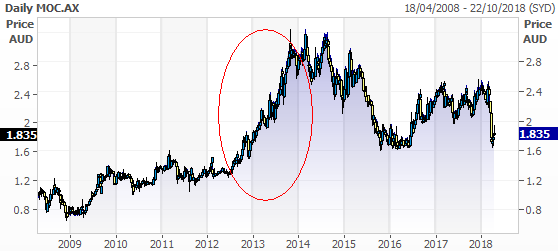Where ideas come from
For individual investors, one of the biggest challenges is uncovering new investment ideas. While fund managers have brokers and investment banks regularly knocking on their doors trying to sell their latest deals, other investors must be more creative. Here are 11 sources of stock ideas for the private investor.
Networking with other investors
A good example would be the Australian Investment Association (AIA) which offers discussion groups in each State and an annual conference on the Gold Coast where over 300 mostly retiree investors get together for a smorgasbord of investment education. You will not make money in shares sitting in a dark room in your unit in Bendigo with the door shut.
Broker research
Yes broker research is biased to optimism as a large number of broker research notes are marketing documents masquerading as independent opinion. But some of the best research you can read has been written by the brokers that are the closest to the companies that they represent. So you don’t have to believe the BUY recommendation or the overoptimistic target price, but you can gain a lot of knowledge, insight and ideas from reading the body of the research.
Upgrades and downgrades
There are quality companies like the Commonwealth Bank that find themselves in sentiment holes at times, as it does now. It is a cheap quality stock with an 8% yield that has at times traded on a price earnings ratio 20% higher than it does now. But it needs a catalyst to re-generate interest. That can often come from keeping your fingers on the pulse of the "earnings cycle" - that is, recognisisng that forecasts are being upgraded or downgraded at the moment. At the moment all the banks are in an earnings downgrade cycle, at some point that will end.
Imagine how many billions would be re-invested in the Commonwealth Bank for its 8% yield if you could guarantee that the share price would not fall from here.
Now imagine how many billions would be invested if the share price actually rose as well. Without blinking an eyelid on valuation grounds the Commonwealth Bank could happily trade 10% higher than it does now, so imagine an 18% return from the Commonwealth Bank in 12 months. The catalyst for that is going to come from a change in sentiment which is more than likely going to be signposted by some broker somewhere upgrading the stock’s earnings numbers and with it their recommendation. And all the other brokers will follow. You will only spot this in the research, which can often be the catalyst for a sentiment resurrection. One of the best websites for tracking broker recommendations is Rudi's FN Arena.
Fund Managers
One of my brothers-in-law started his broking career sitting next to a Melbourne legend. That broker told him that the way to stockbroking success was to find a company with half an idea that is trading below one cent, buy millions of shares, and spend the rest of your career marketing it.
In the same way there is a game that has been played in the stock market since time began which involves people buying shares and then telling everybody else all about it. And why not. If you think it’s a good idea it makes sense, having bought it, to tell everybody else. This is now routine behaviour for midcap, small cap and micro-cap fund managers. Buying something and telling everybody else about it. More often than not when a fund manager buys a small stock they have to take a long-term view because the liquidity isn’t there to allow them to trade in and out. So, when you hear them talking a stock up, more likely than not they genuinely believe it is a good investment in the long-term and, having just bought it, and having just started to tell everybody about it, it is probably still early in the piece.
Top 20 shareholders
Our systems can bang out a list of the top 20 shareholders for any stock including their most recent transactions, buying or selling. Before buying any stock it is worth checking the substantial shareholders notices to see who has been doing what. You don’t want to walk into a big fund manager selling a large stake in a small company even if the fundamentals “look great”. It is often when a company is running hard with the tide, with nothing going wrong, that fund managers decide to offload their large holding into the demand. Important to know whether that process is happening before you join the party. I call it an analysis of “The Flow”. See this article on analysing "The Flow."
Shorting
There is a great website called Short Man in Australia that allows you to monitor the short position in any stock. This is a great piece of information and if you’re looking for ideas, look no further than the most shorted stocks. These are almost always companies that offer good trading opportunities (rather than investing opportunities) because a large short position tends to mean the stock is more volatile and capable of moving quickly, sometimes very quickly, and often by a decent amount, as shorts cover when things go right. A lot of these stocks should be sitting on your “Opportunity watchlist”. For more sensible investors it is often a list of stocks to avoid!
Director share sales
Always interesting to know whether a director is actively selling their own company. On occasion this has been an essential piece of mostly negative information. It is a laborious process opening Director Shareholding notices in PDF form to find this information out. But one of the best places to check that out is the Market Index website which does it for you. You can check any company there but you can also regularly check the last 100 director transactions. 90% of them are directors buying, often as they get given shares or exercise options, but just occasionally there are some very large transactions, mostly on the selling side. A Domino’s Pizza (DMP) director for instance recently sold a few large blocks of shares. That’s telling you something.
Earnings Announcements
Earnings announcements de-risk a stock. Because of continuous disclosure requirements companies no longer communicate incrementally with the market but tend to dump all the news in one announcement, often with the results announcement. This has rendered the results season a very dangerous period of time in under-researched stocks.
Investing in small and mid-cap companies over the results season has become a dangerous activity which I liken to running around the battlefield during an artillery barrage in an orange vest. You never quite know when you’re going to be blown up.
Post results share price reactions have become ludicrous, enhanced as they are by high-frequency trading which chases share price trends for an hour or so and in so doing exaggerates share price reactions. The high-frequency trading algorithms are even picking up on the adjectives in announcements these days, in order to get ahead of the rest.
Last year for instance, WorleyParsons fell 20% on the day of its results only to bounce 10% later the same day. This is a $4 billion market cap company. Between announcing results at 8:30 AM and the share price reaction two hours later you cannot tell me that anybody did enough in-depth research to calculate that the company valuation should legitimately be 20% lower on that one announcement. But the beauty of results is that after results announcements that “shock drop” risk disappears for a few months. You also, after results, have the most up-to-date information on the company available.
So post results is a fabulous time to make a few investment decisions with the lowest level of information risk. If you are looking for ideas then the day after results is a good time to assess them.
Your own inside information
I have written about this many times, that some of the best insights into stocks comes from your own observations. Call it inside information if you like, but it is perfectly legal. Looking around your world, your industry, your colleagues, your friends. Keeping your eyes open on the streets, in the newspapers, in the budget papers, constantly assessing whether there is something patently successful in front of you that translates into a listed company you could buy and make money out of.
I give the example of seeing a colleague a few years ago who ran a Mortgage Choice franchise buying a new Mercedes. I bought the stock at around 140c and sold it at 300c when it went into downtrend catching the uptrend marked on the chart below. There is a lot of money to be made out of your own observations, all you have to do is realise there could be easy money right in front of you and keep your stock market antennae constantly on alert in your everyday life.
Themes and trends
I talk regularly about “swimming with tide” when buying stocks. That means buying when the odds are in your favour rather than against you (and selling when the tide turns). The optimal conditions for buying are when the market is going up and you are buying a stock in an industry that is backed by a strong theme. The tide is often dictated by capex. Where is the money being spent?
One of the best places to read about successful industries and the trends in capital expenditure is in the government budget papers. Reading that the education and tourism industry contributions to GDP are growing significantly is telling you that the tide is running with those sectors. After that the stocks pretty much pick themselves. Similar big themes would include economic growth generally, there are a lot of cyclical stocks linked to GDP; interest rates rising or falling, they impact a lot of companies; the trend in the Australian dollar, it’s good for a lot of companies if it falls; the trend in retail sales, retail stocks tend to be sensitive to many short-term trends which makes for good trading stocks; commodity prices, half the Australian market is dependent upon the commodity price cycle.
And that’s just a few. Find a strong theme and the stocks pick themselves.
Technical software
Many traders do daily scans of the 2244 listed Australian stocks looking for a confluence of technical buy and sell signals that might trigger a successful trade. We do it ourselves on behalf of Marcus Today members and report on it in the TRADING PORTFOLIO section.
But this process has a fundamental flaw. In the end you can end up with 10 or 20 ideas driven by technical (chart) observations every morning. While this might appear to be an interesting and healthy process, my experience is that it generates too many ideas rather than a few good ideas. One good idea a year makes for a good year for an investor (A2M was last year’s idea for instance), why dilute the pursuit of that one good idea by generating 20 ideas a day that camouflage the diamonds and are often based upon short-term technical factors that can expire tomorrow. You can have too many ideas.
Marcus Padley is the author of the Marcus Today stock market newsletter. To sign up for a 14-day free trial please click here.
4 stocks mentioned


